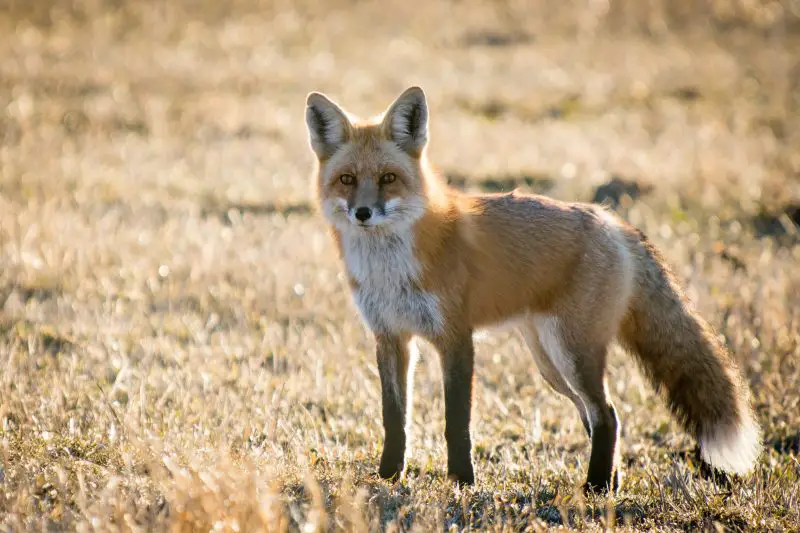If you’ve ever lain awake in a cabin in Colorado or gone camping in the foothills, you might have heard it — a sudden scream tearing through the quiet night. It sounds human, desperate, almost haunting. But it’s not a person. It’s a fox.
Foxes in Colorado are surprisingly vocal animals, known for their wide range of sounds that echo through valleys and suburbs alike. Their eerie cries, sharp barks, and strange chattering noises can startle anyone unfamiliar with them. Yet every sound they make has purpose and meaning.
In this guide, we’ll explore why Colorado’s foxes make such strange noises at night, what these sounds represent, and how they reflect the fascinating social life of one of the state’s most adaptable wild animals.
Foxes of Colorado: A Nocturnal Presence

Colorado is home to two main fox species — the Red Fox (Vulpes vulpes) and, less commonly, the Gray Fox (Urocyon cinereoargenteus). Of the two, the red fox is the one most people encounter. Its reddish coat, white-tipped tail, and black “stockings” are instantly recognizable.
Red foxes thrive across the state, from the plains near Fort Collins to the wooded foothills west of Denver. Their adaptability is remarkable; they can live just as comfortably near mountain streams as they do in quiet suburban neighborhoods. It’s this adaptability that brings them close to people — and makes their nighttime voices a familiar, if eerie, part of life in Colorado.
Despite their proximity to humans, foxes remain wild and wary. Most people rarely see them, but almost everyone who lives near wooded or rural areas has heard their calls in the stillness of night.
What Do Fox Noises Sound Like?
Foxes are known to produce more than a dozen distinct sounds, each serving a different purpose. Some are short and sharp, others long and unsettling. The most recognizable, the so-called vixen’s scream, can carry for miles on a cold winter night.
A fox’s bark is quick and high-pitched — not unlike a small dog’s, but sharper and with a curious tone that almost sounds like laughter. Their screams, on the other hand, are piercing and drawn-out, often mistaken for a person crying out. Then there’s the strange, chattering “gekkering” noise that erupts when foxes quarrel or play.
At first, it might seem chaotic. But to foxes, these sounds form a sophisticated language — one that helps them navigate the challenges of night life in Colorado’s wild landscapes.
The Mystery of the Night: Why They’re So Loud After Dark
Many people wonder why foxes are so vocal at night, especially in winter. The truth lies in their natural rhythm and social structure.
Foxes are nocturnal by nature. They prefer to hunt, travel, and communicate when darkness falls and human activity slows. The cooler air at night also carries sound farther, allowing them to communicate over greater distances. In the open foothills and wide valleys of Colorado, a single fox call can echo for miles.
Nighttime is also when foxes feel safest to express themselves. Fewer predators are active, fewer people are moving around, and the quiet amplifies every cry, bark, and whine. What seems loud or alarming to human ears is perfectly normal in the life of a fox.
Love Calls in the Cold: The Breeding Season
If there’s one time of year when foxes become especially noisy in Colorado, it’s winter. Between January and March, the red fox breeding season begins, and the nights come alive with haunting sounds.
The female’s scream — the “vixen’s call” — is perhaps the most chilling of all. It’s a long, wailing cry that announces her readiness to mate and helps males locate her. Males answer with shorter barks, signaling their interest or warning rivals to stay away. These vocal exchanges can continue for hours as pairs locate each other under the stars.
In suburban areas, where sound travels easily between houses, it’s not uncommon for residents to be woken by these eerie duets. While unsettling, they’re simply part of nature’s winter rituals — foxes following the timeless rhythm of courtship.
Territorial Talks in the Moonlight
Beyond romance, foxes use their voices to defend what’s theirs. Every fox maintains a home range — a territory that may stretch across several miles of forest, field, or neighborhood edge.
A sudden burst of barks in the night can signal a challenge. When two males meet at a boundary, they often exchange sharp barks or bursts of gekkering — a harsh, chattering noise filled with growls and clicks. This is their way of saying, “This is my ground.”
The intensity of these encounters often peaks in winter and early spring, when competition for mates and dens is highest. Though fierce-sounding, most of these conflicts end without a fight. Foxes rely on sound to settle disputes long before they turn physical.
Family Communication: A Language of Their Own
When spring arrives and kits are born, the tone of fox communication changes. The den becomes a lively hub of squeaks, whines, and soft chirps. Parents use gentle sounds to guide and reassure their young, while kits practice the very vocal skills they’ll need as adults.
If you happen to hear a series of playful yips or trills near a wooded area in May or June, you’re likely listening to a family of foxes at play. These interactions are essential for bonding and for teaching the young survival behaviors.
Even outside the den, fox families remain vocal. The adults communicate while hunting or guarding territory, using barks and whines to signal danger or coordinate movements. For a creature that seems solitary, foxes actually lead rich social lives full of communication.
Why Fox Calls Sound So Unnerving
One of the reasons fox sounds seem so eerie to humans is the quality of their voices. Foxes have narrow vocal cords that produce high-frequency tones, giving their calls a shrill, almost human-like quality.
At night, the still air amplifies these sounds and carries them over long distances. In valleys or residential areas bordered by hills, echoes can distort the sound further, turning a simple bark into something otherworldly.
Many first-time listeners think they’re hearing a child scream, a cat fight, or even a supernatural voice in the woods. But to the fox, it’s just a way to talk — a perfectly ordinary part of survival.
The Urban Fox: Voices in the Neighborhood
As Colorado’s cities expand into natural habitats, foxes have adapted beautifully. It’s now common to hear foxes calling in suburban areas like Boulder, Colorado Springs, or Fort Collins. They roam through greenbelts, golf courses, and even residential backyards at night.
In these environments, they often become more vocal because their territories overlap and competition for food sources like rodents, rabbits, and trash bins intensifies. While it can be startling to hear a scream echo through a neighborhood at midnight, these urban foxes are simply doing what their ancestors have done for centuries.
Their presence is a sign of balance — a reminder that even in developed areas, Colorado’s wild side endures.
Living Alongside Colorado’s Night Voices
For homeowners and campers alike, understanding fox behavior helps turn fear into fascination. The best thing you can do when you hear them is to listen, not react.
Foxes pose little to no danger to humans. They avoid confrontation and typically pass through areas without causing harm. Feeding them, however, can lead to problems. When foxes associate people with food, they lose their natural caution and may become bold or dependent.
If you live in an area where foxes are active, keep garbage sealed, bring pet food indoors at night, and supervise small pets during the evening. Most importantly, enjoy the experience of sharing space with one of Colorado’s most charismatic wild neighbors.
The Science Behind the Sound
Researchers studying fox communication have discovered that red foxes use a complex system of calls — as many as 20 unique vocal patterns have been documented. Each serves a distinct function, from courtship to warning cries.
Foxes can locate the source of a sound with remarkable precision, an ability that helps them both hunt and avoid danger. They also tailor the pitch and rhythm of their calls depending on distance and context. A low bark may work for a nearby partner, while a long scream carries across hills and valleys.
These vocalizations demonstrate a high level of intelligence and social awareness. For foxes, sound is as essential as sight or smell. It connects families, maintains territories, and ensures survival in an ever-changing landscape.
The Best Time to Hear Foxes in Colorado
Winter nights are the most dramatic. Between December and February, the cold air is still and clear, perfect for carrying sound. That’s when the breeding calls peak, and their cries feel almost supernatural echoing through the snow.
Spring nights bring a gentler music. Kits exploring outside the den chirp and whine as they play. Adults exchange softer calls as they hunt under the moon. By summer, the noise quiets down, though you might still hear the occasional bark or whimper in the distance.
Wherever you are — from the pine forests of Estes Park to the grassy fields near Pueblo — the night belongs to the foxes.
Why You Shouldn’t Fear Their Sounds
To many people, the sounds of foxes are unsettling. But once you understand them, they become a sign of vitality and balance. Hearing foxes in Colorado means the ecosystem around you is thriving.
Their presence keeps rodent populations in check, reduces agricultural pests, and contributes to the state’s biodiversity. These calls are the heartbeat of the night — not something to fear, but something to cherish.
So next time you hear that high-pitched scream or strange bark echo through the dark, pause for a moment. Don’t think of it as a disturbance. Think of it as communication — a glimpse into the secret world of one of Colorado’s most fascinating wild residents.
FAQs About Foxes in Colorado
Why do foxes scream at night?
They scream primarily during the breeding season to attract mates or defend territory. It’s completely normal behavior.
Are foxes dangerous to humans?
Generally no. Healthy foxes avoid human contact. However, never attempt to feed or approach one.
Can foxes live in urban neighborhoods?
Yes. Foxes have adapted extremely well to urban environments across Colorado. They find food easily and use quiet spaces to raise young.
What should I do if I see a fox near my home?
Observe it from a distance and ensure food sources (like trash or pet food) are secured. Foxes typically move on once they realize there’s nothing to scavenge.
Why do foxes sound like they’re fighting?
They often engage in playful or competitive “gekkering,” which sounds like aggressive chattering but is a normal social interaction.
Final Thoughts
Foxes in Colorado are storytellers of the night. Every scream, bark, and chatter is a piece of their language — a way to find love, defend a home, or simply stay connected. Their strange nocturnal noises remind us that even in quiet neighborhoods, nature is alive and speaking.
If you listen closely, the darkness isn’t silent. It’s filled with the voices of the wild — voices that have echoed through the mountains and plains of Colorado for centuries.
The next time you hear them, don’t be alarmed. You’re simply hearing the wild heartbeat of Colorado, calling softly through the night.






